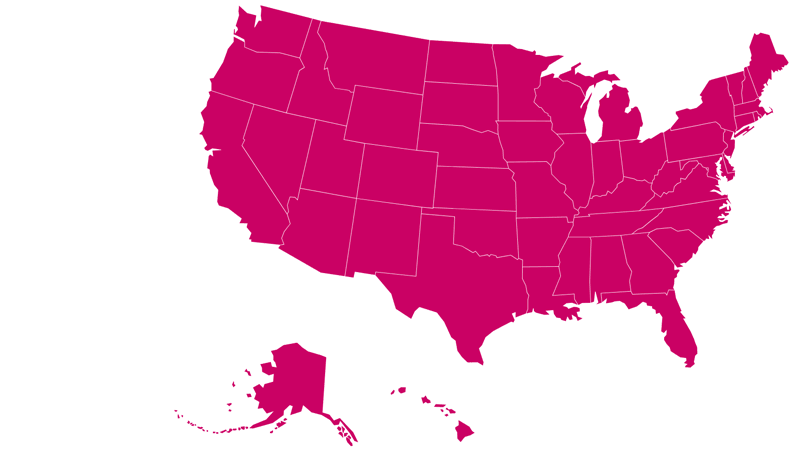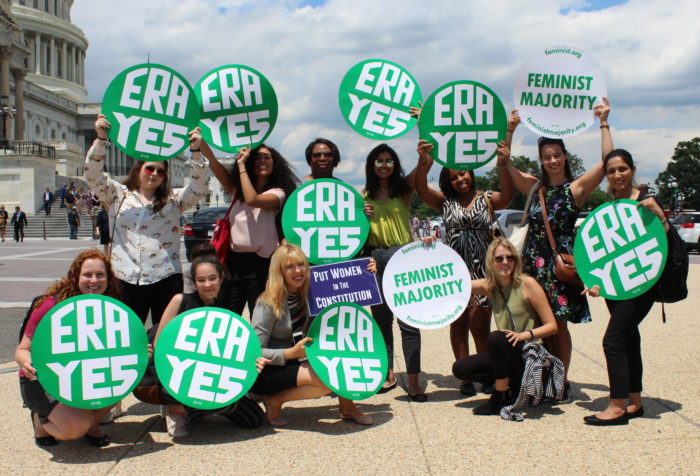
What You Need to Know
The Equal Rights Amendment (ERA) is a proposed amendment to the U.S. Constitution prohibiting the denial of equal rights on the basis of sex. With Virginia’s ratification of the ERA on January 27, 2020, the amendment has met the 3/4 states threshold to be added to the Constitution. Proponents of the ERA believe all requirements to become the 28th Amendment have been met; however, opponents argue that the timeline in the ERA’s preamble, which was not voted on by the states and will not appear in the Constitution, has expired. Join us in the fight to enshrine the ERA in the Constitution—the supreme law of the U.S.—because there is no time limit on equality.
A Brief History
The ERA, authored by prominent suffragist and National Woman’s Party leader Alice Paul, was first introduced in Congress in 1923, and then again in every Congressional session until it passed in 1972. In its original form, as drafted by Alice Paul, the first section of the ERA read: “Men and women shall have equal rights throughout the United States and every place subject to its jurisdiction.” In 1943, however, the Senate Judiciary Committee amended this language to read: “Equality of rights under the law shall not be denied or abridged by the United States or by any State on account of sex.” When the ERA finally passed, section 1 contained the 1943 language.
38 states must ratify an amendment before it can become part of the U.S. Constitution. Like every proposed constitutional amendment, after passing by a two-thirds vote in both the House and Senate, the ERA was sent to the states for ratification.
Equality of rights under the law shall not be denied or abridged by the United States or by any State on account of sex. The Congress shall have the power to enforce, by appropriate legislation, the provisions of this Article. This Amendment shall take effect two years after the date of ratification.
The ERA is simple:
the entire amendment is
only three sentences.
Hawaii was the first state to ratify, less than an hour after the ERA passed out of Congress. Other states quickly followed. By January 1977, 35 states had ratified the amendment. With the end of the seven-year timeline approaching, women’s rights activists led by the National Organization for Women (NOW) took to the streets to demand removal of the timeline. Tens of thousands marched in Washington in 1978 as a result of NOW’s comprehensive campaign and hundreds of thousands more sent telegrams to Congress, shutting down Western Union, the largest provider of telegrams in the country at the time.

The ERA is popular:
76% of states have now
ratified the amendment.
Congress eventually granted an extension of the timeline until June 30, 1982. But the opposition to the ERA—led by Chambers of Commerce, the National Association of Manufacturers, and the insurance industry—was also organized and managed to hold back ratification in 15 states. When the timeline expired, no new states had ratified. The campaign was still three states short.
Since then, activists in unratified states have worked to clear a path for the ERA. On March 22, 2017, Nevada became the 36th state to ratify the ERA. Just over a year later, Illinois followed suit. In January of 2020, Virginia become the 38th and final state needed to ratify the ERA. The 12 states that have not yet ratified the ERA are: Alabama, Arizona, Arkansas, Florida, Georgia, Louisiana, Mississippi, Missouri, North Carolina, Oklahoma, South Carolina, and Utah.
Even before Virginia’s ratification, the Department of Justice’s Office of Legal Counsel under the Trump administration issued a memo instructing the National Archivist not to certify the ERA on the grounds that the timeline has expired. The fight now moves to Congress and the courts. But why is the ERA still so contentious, especially now, when so many people verbally support women’s equality?
Because the ERA’s ratification is not just symbolic—it would have a real impact on people’s lives. Laws prohibiting sex-based discrimination are subject to the whims of Congress and can be changed, gutted, or even eliminated with a simple majority vote and the signature of the President. Further, the judicial wing of government has limited and gutted federal statutes prohibiting sex discrimination via the conservative majority of the Supreme Court. Former Justice Antonin Scalia, notable for his originalist perspective on interpreting the Constitution, stated in 2011 that nothing in the U.S. Constitution prohibits sex discrimination.
The drive to ratify the ERA in the 1970s and 1980s spurred a vigorous women’s rights movement that made impressive gains in education, employment, health insurance, ending violence, obtaining financial credit, athletics, reproductive health and rights, and so much more, but these gains have been under constant attack. In 2014, the Supreme Court’s ruling in Burwell v. Hobby Lobby rolled back gains for reproductive healthcare made through the Affordable Care Act (ACA), ruling that closely-held, for-profit corporations could discriminate on the basis of sex by refusing to provide health insurance coverage for FDA-approved contraceptives in employee health plans.
The Continued Need for the ERA
The ERA would provide a constitutional basis not only to protect the gains we have won, but also for future proactive legislation. For example, when the Violence Against Women Act (VAWA) was passed in 1994, it prioritized ending gender-based violence and empowered survivors to seek their own justice through a private, civil right of action against perpetrators—even if the state failed to prosecute. That same year, a college survivor attempted to use VAWA to sue her rapist and her university for mishandling her sexual assault claim. The courts prevented her case from moving forward, and the Supreme Court later ruled that Congress had no constitutional authority to enact the VAWA provision that authorized her lawsuit. The ERA would give Congress the Constitutional backing to enact provisions like these.
Check out our factsheets for talking points on why we still need the ERA!

The ERA is powerful:
it would add sex-based equality
to the highest law in the U.S.
Current Status of the ERA
On March 28th, 2023, Rep. Ayanna Pressley (D-MA-7) and Rep. Cori Bush (D-MO-1) launched the first ever Congressional Caucus for the Equal Rights Amendment. Rep. Pressley introduced a joint House resolution, H.J. Res. 25, to remove the deadline on the ERA’s ratification and affirm the ERA as the 28th amendment to the U.S. Constitution. An identical resolution was introduced in the Senate, and on April 27th, 2023, the Senate debated the resolution. However, the vote to advance the resolution to the floor failed to overcome the filibuster, 51-47. Republican leadership in the House refused to schedule a vote on the resolution.
On March 24, 2025, Rep. Pressley again introduced a joint House resolution to establish the ratification of the Equal Rights Amendment, H.J.Res.80. Senators Mazie Hirono (D-HI) and Lisa Murkowski (R-AK) introduced an identical Senate resolution with the following text:
Resolved by the Senate and House of Representatives of the United States of America in Congress assembled, That notwithstanding any time limit contained in House Joint Resolution 208, 92d Congress, as agreed to in the Senate on March 22, 1972, the article of amendment proposed to the States in that joint resolution is valid to all intents and purposes as part of the United States Constitution having been ratified by the legislatures of three-fourths of the several States.
Legal precedent supports Congress’ power to set or revise ratification timelines and decide if an amendment has been properly ratified. In Coleman v. Miller (1939), the Supreme Court affirmed that only Congress can determine whether a long-pending amendment remains valid. Therefore, the passage of the joint resolution alone would be sufficient to officially recognize the ERA as a ratified constitutional amendment. Neither the President nor the courts play a role in this process.
State-Level ERAs
In addition to the U.S. Constitution, every state must abide by its own individual state constitution. Therefore, advocates for sex-based constitutional equality have always had a parallel strategy on the state level, organizing to amend state constitutions to guarantee protection against sex discrimination while also working to ratify the federal ERA. 26 states have adopted state constitutions or constitutional amendments that prohibit the denial of equal rights under the law based on sex, including three states that have yet to ratify the federal ERA.
States have interpreted these provisions in various ways. Most state courts interpreting state-level ERAs apply “strict scrutiny” to gender-based classifications in the law, a higher standard than currently applied at the federal level. This means the government must not only have a compelling reason to discriminate, but the law must be narrowly tailored to achieve its goal – making it more difficult for lawmakers to pass laws that discriminate based on sex. Other states, such as Pennsylvania, apply an even higher, absolute standard, prohibiting almost all gender-based classifications.
